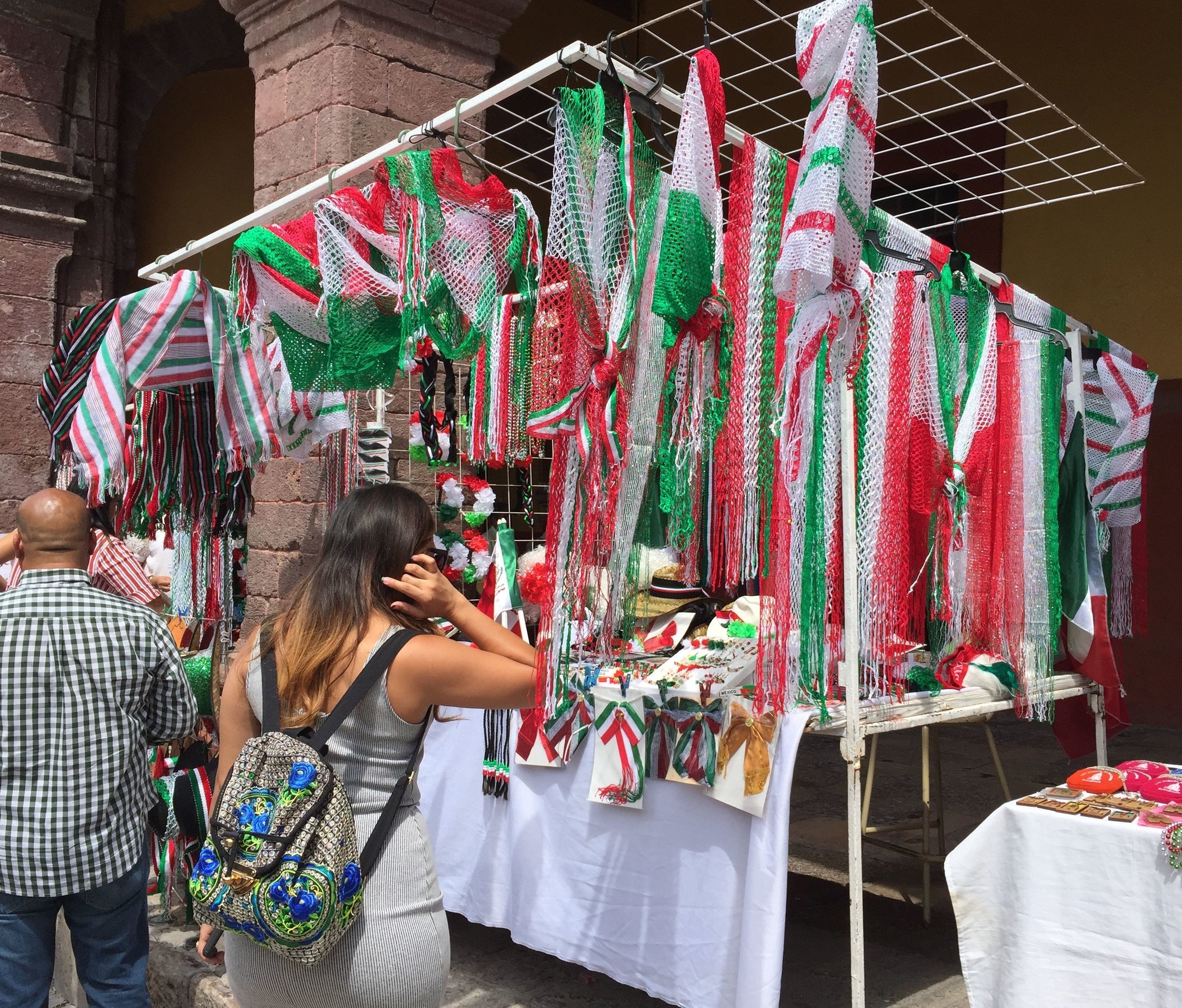As a student of history, I’m familiar with all the important dates on the timeline of America - February 14 - Valentine’s Day; April 24 - Administrative Professional’s Day; and September 19 - International Talk Like a Pirate Day (although technically an international holiday, the idea that everyone should talk like a pirate was originated in the U.S. in 1995 so it counts on our register of achievements. Cha-ching!)
But, in this day and age where blind patriotism is so valued, it is shocking to me - shocking! - that I have never had the honor of driving down February 19th Boulevard (President's Day), had a fountain soda on Fourth of July Street, or been able to honor our veterans by reciting the alphabet backwards while balancing on one leg and touching my nose on November 11 Road.
Things are different in Mexico. In Mexico, they remember their important dates not by looking at a calendar, but by using them as street names. In San Miguel de Allende, I can order a beet juice on 20 de Enero, step boldly to avoid landing in a pile of dog crap on 28 de Abril, or order a Corona on Cinco de Mayo (technically, I can also order a Corona on Cinco de Mayo in the U.S., but I can’t order a Corona on Cinco de Mayo in the U.S. while actually standing on a street named Cinco de Mayo like I can in Mexico. Cha-ching!)
Town Hall in San Miguel de Allende got dressed up in anticipation of Mexican Independence Day on September 16.
So, as a recent transplant to Mexico and in an attempt to better understand the country’s long and colorful history, I did a little research so I would know what emotion I should feel (besides anger) if I ever happen to be stuck in traffic on 20 de Noviembre. This is what I found:
20 de Enero
I’m not completely sure about this one. My first source, the San Miguel events calendar, indicates that January 21 is the birthday of Ignacio Allende, the town's "favorite son" and namesake, born in 1769. It would be nice to think that this is what the street commemorates.
However, since the street is actually named January 20, I went to a second, more reliable, source. Wikipedia indicates that on January 20, 1532, the Spanish founded the town of San Sebastian, in Zacatecas state, Mexico. This is a silver-rich region of the country which the Spanish would soon exploit - killing or enslaving much of the indigenous population in the process.
Given Mexican’s propensity for celebrating events that lead to the suppression of their religious beliefs and cultural identity, I would put my money down that the street is commemorating this latter event.
My hunch may be supported by that fact that a band named ‘The Ear of Van Gogh’ has a song titled “20 de Enero,” which talks about the encounter of a young couple getting off the train in San Sebastian during a drum festival typical of many Spanish towns. I am not making this up.
5 de Febrero
Venustiano Carranza. He looks like a nice guy. Who would think that he had a coup in him?
President Venustiano Carranza declared February 5, 1917, to be Mexican Constitution Day. The national holiday celebrates the promulgation of a new and improved Constitution by a Carranza-convened constituent Congress. The 1917 Constitution replaced the 1857 Constitution, which didn’t go far enough in guaranteeing equal rights and freedoms to all Mexicans. Carranza himself, of course, came to power by staging a coup against the presidency of Victoriano Huerta. Ah, democracy.
28 de Abril
This date commemorates the Battle of Las Cubres in 1862 - a skirmish between Mexican forces and an invading French army in which Mexicans held the high ground. It precedes the more significant Battle of Puebla by several days - see below.
Street sign for April 28th Street in San Miguel de Allende, Mexico
It is also the birthday of novelist Harper Lee (b. 1926), dictator Saddam Hussein (b. 1937), Supreme Court Justice Elena Kagan (b. 1960), and my cousin, Michael Greve (b. 1982).
5 de Mayo
Not many people know that Mexico was under French rule for several years in the mid-1800’s. The Mexicans were not paying their debts and the French were not happy. Rather than sending a bill, they sent an army.
The first major armed confrontation between Mexican forces and the invading French took place on May 5, 1862, near the city of Puebla. Surprisingly, the outnumbered and poorly equipped Mexican troops prevailed. Cinco de Mayo celebrates this unlikely victory.
Many stands selling Mexican-flag themed trinkets pop-up around town on dates important to Mexican independence
The bubbly did not flow for long, however. The French eventually overran the Mexicans, allowing Napoleon III to crown his brother Maximilian ‘Emperor of Mexico.. There’s a castle in Mexico City with a spectacular view where the Emperor and his wife lived until he was finally captured and executed on June 19, 1867. I have not yet seen a street dedicated to this event.
16 de Septiembre
This date is considered to be Mexico’s Independence Day - and we eagerly await its celebration this weekend in what has been described to us as an all-night raucous party of beer and fireworks - reminiscent of our own celebration of Independence Day on July 4. Though, similar to July 4, the origin is more inspired.
I bet you didn’t know, flags make good capes
In Mexico, way back in 1810, Father Miguel Hidalgo stood in the pulpit of his church in the town of Dolores and exhorted his parishioners to throw off Spanish rule and tyranny. Known as the “Grita de la Independencia” (alternatively, for you English speakers, the “Cry of Dolores”) it was the spark that ignited Mexico’s revolution for independence from Spain. Although things didn’t end well for Hidalgo (he was captured and beheaded in 1811), if I ever did a blog post about streets that are named after famous Mexicans, this guy would be at the top of the list.
20 de Noviembre
In Mexico, you can’t just start talking about ‘the revolution’ and expect people to know what you are talking about - the country has had several of them. This date in November is the day set by Francisco Madero - the loser of the 1910 Mexican presidential election which he claimed had been rigged - for Mexicans to rise up and overthrow long time dictator Porfirio Diaz.
Unfortunately, this is not a flyer for a play, though, Mexican history is certainly entertaining. This particular revolution spawned such Mexican folk heroes as Pancho Villa and Emiliano Zapata, and saw the presidency change hands 4 times in ten years.
Many Mexicans heeded the call to revolution - including populist heroes Emiliano Zapata and Pancho Villa - spiraling the country into years of political backstabbing, suppression, and murder, but not effective reform. The recently elected president Antonio Manuel Lopez Obrador (AMLO) is the latest hope. Perhaps we will soon be attending a new street-naming ceremony.







